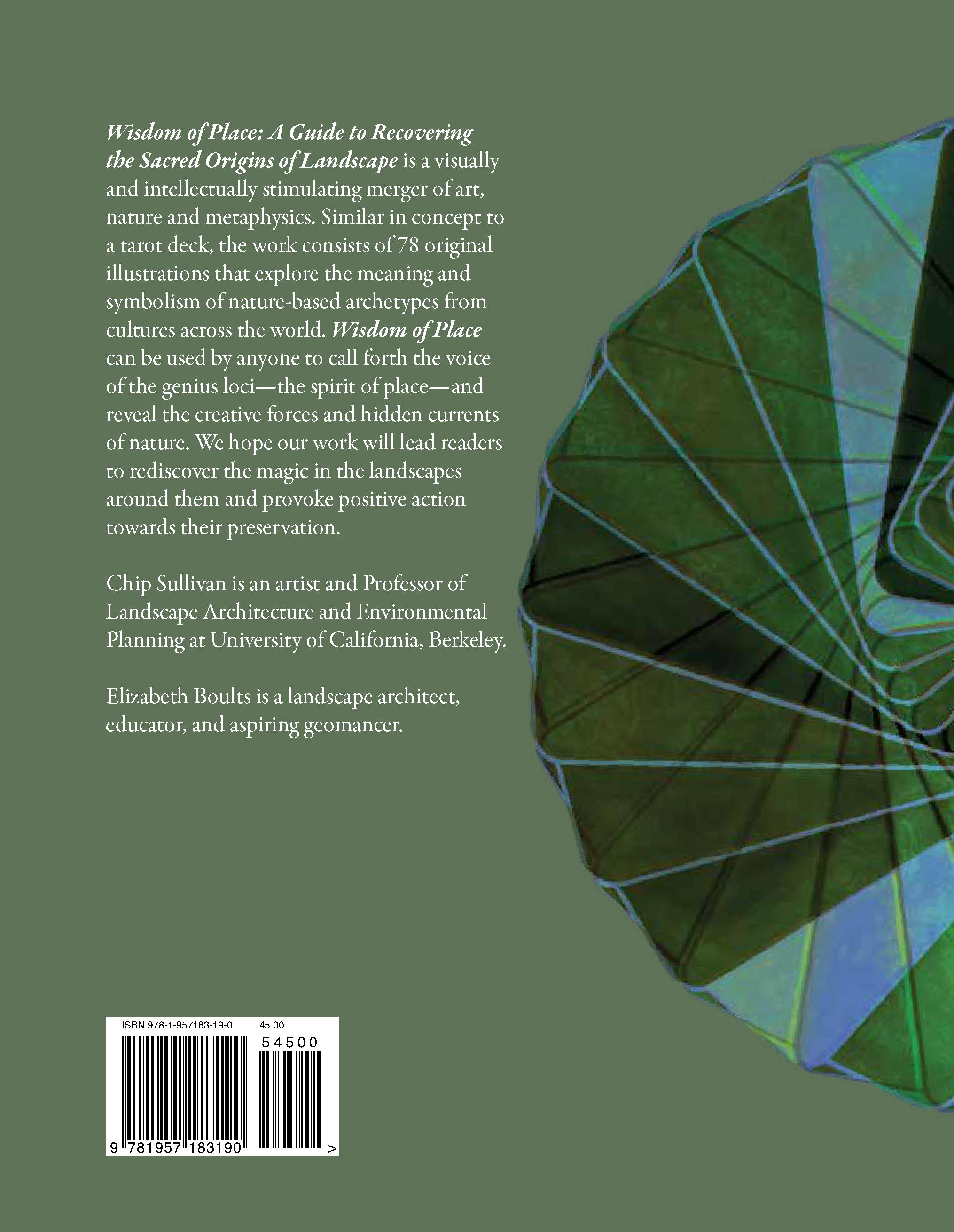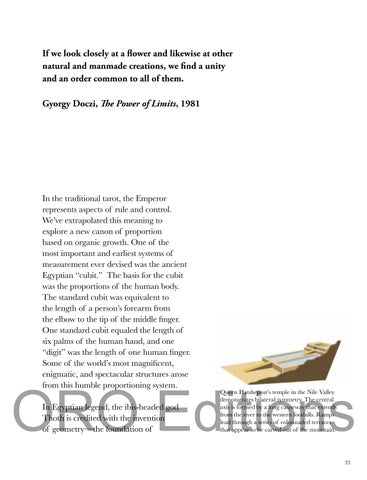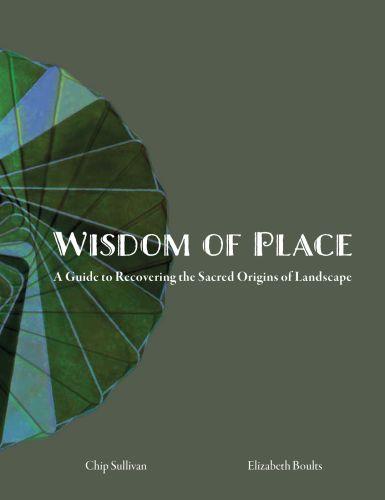

THE GREEN MAN
ORO Editions
Spring drew on...and a greenness grew over those brown beds, which, freshening daily, suggested the thought that Hope traversed them at night, and left each morning brighter traces of her steps.
Charlotte Brontë, Jane Eyre, 1847Our story of the search for wisdom of place begins with the Green Man. His character is based on the protagonist known as The Fool, who is traditionally represented by the primary card of the major arcana in the tarot allegory. Like the Fool, the Green Man is about to undertake a journey with confidence and faith. He is poised to step off the precipice and into the magical realm of the genius loci The precipice represents the edge of the known world, the border of the regions in which dwell the hidden forces of nature.
The Green Man is a folkloric forest figure typically portrayed with attributes of both wild nature and human nature. Garbed in leaves and branches, the historical character remains vivid in our collective imaginations, sharing traits with Dionysus and Pan as well as with Robin Hood and ‘‘Jack-in-the-Green’’—who appears to this
Dionysus was the Greek god of agricultural productivity and renewal based on the myth of his rebirth. Like his Roman counterpart Bacchus, he became known as the god of wine and was often associated with sensational festivals of abandon that took place in nature.
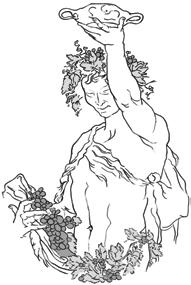
ORO Editions
day at May Day celebrations throughout Britain. In myths and legends from around the world, the Green Man is often depicted as a nature spirit, a god of fertility and a symbol of rebirth who personifies the mysteries of the spring season. Metaphorically, the Green Man represents the imperative of environmental awareness, the subconscious desire for an agitator of the “green” revolution today.
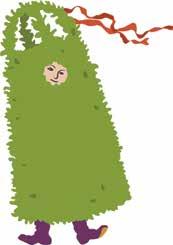
ORO Editions
the green man
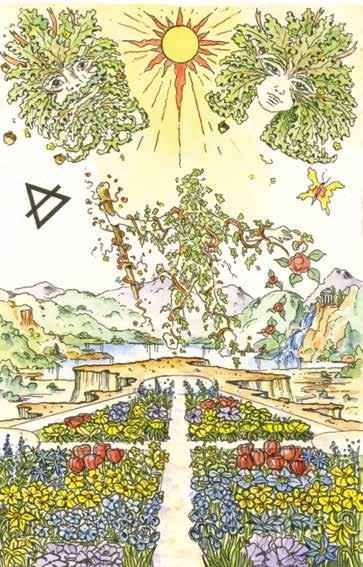
ORO Editions
IV
ORGANIC PROPORTION
ORO Editions
If we look closely at a flower and likewise at other natural and manmade creations, we find a unity and an order common to all of them.
Gyorgy Doczi, The Power of Limits, 1981In the traditional tarot, the Emperor represents aspects of rule and control. We’ve extrapolated this meaning to explore a new canon of proportion based on organic growth. One of the most important and earliest systems of measurement ever devised was the ancient Egyptian “cubit.” The basis for the cubit was the proportions of the human body. The standard cubit was equivalent to the length of a person’s forearm from the elbow to the tip of the middle finger. One standard cubit equaled the length of six palms of the human hand, and one “digit” was the length of one human finger. Some of the world’s most magnificent, enigmatic, and spectacular structures arose from this humble proportioning system.
ORO Editions
In Egyptian legend, the ibis-headed god Thoth is credited with the invention of geometry—the foundation of
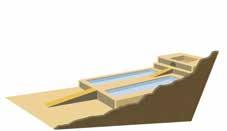
proportion and scale. We illustrate the tools of Egyptian measurement in the hieroglyphics shown below the image of Thoth. At the base of the illustration is a cubit rod inscribed with incremental units. The digit, emerging from a human hand, points the way to a “green” future.
Our vision of an alternative system of proportion is based on natural patterns of efflorescence—how a plant develops from seed germ to final form. The seed germ depiction is inspired by the organic designs of American architect Louis Sullivan (1856-1924). Sullivan believed that design should be alive and arise from the organic patterns of nature and thus animate the spirit of the building.
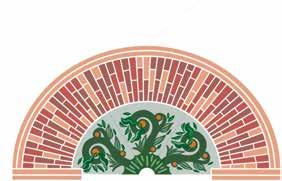
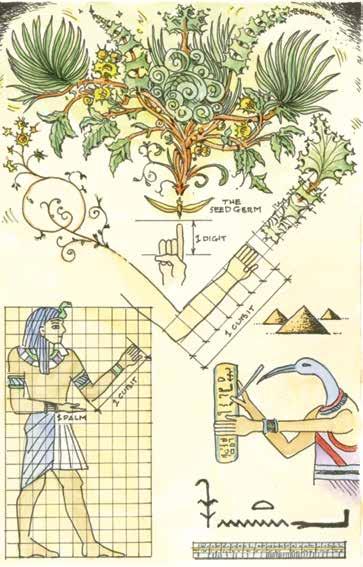
DEEP ECOLOGY IX
ORO Editions
We are spiritual beings having a human experience.
Jane Goodall, Reason for Hope: A Spiritual Journey, 1999
The Hermit traditionally is the ninth card of the major arcana. As indicative of the search for consciousness that lies at the roots of one’s reality, we have expressed the Hermit as embodying the concept of Deep Ecology. Deep Ecology is a philosophical position that argues for the value of a holistic consideration of the web of life, one in which humans are not at the center. “Biocentrism” is a similar term that refers to the belief in the equal value and purpose of all living beings; deep ecology extends the frame to include the worth of entire habitats and ecosystems, encompassing all nature. Supporters of Deep Ecology paint humans as just one part of the picture.
ORO Editions
Many governments have granted rights to environmental systems. In 2008, Ecuador amended their constitution to recognize the rights of all nature.
An ecosystem is an interconnected web wherein all living and non-living matter are dependent on each other. One path of energy transfer throughout the web is the food chain.

In 2017, “environmental personhood” was granted to the Ganges and Yamuna rivers in India and the Whanganui River in New Zealand. In 2019, Bangladesh (home to the world’s largest delta ecosystem) gave all its rivers the same legal protection as humans. Undoubtedly difficult to enforce, these legislations are a positive step toward greater environmental awareness and shared responsibility of the earth’s health and well-being.
Our illustration captures the intricacy and richness of the plant and animal kingdom that exists beyond an anthropocentric perspective.

ORO Editions
deep ecology
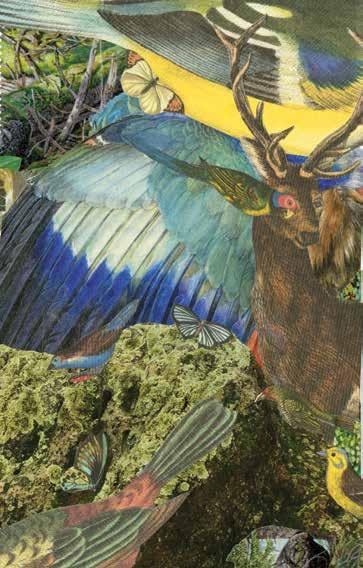
ORO Editions
GENIUS LOCI
ORO Editions
Dwelling means to gather the world...
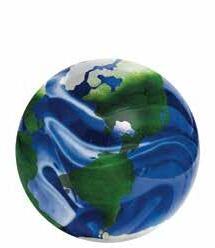 Christian Norberg-Schulz, The Phenomenon of Place, 1976
Christian Norberg-Schulz, The Phenomenon of Place, 1976
The World is the final card of the major arcana in a traditional tarot deck; it symbolizes the successful completion of the journey begun by the Fool. Thus, our search for environmental consciousness concludes with one of the most fundamental concepts of being and dwelling in the world— the Genius Loci or “spirit of place.” Throughout history, people of all cultures have shaped their environments according to instinctive and localized understandings of natural phenomena. In a sense, “placemaking” was a sacred act, grounded in a deep respect for the power of the earth’s dynamic systems.
ORO Editions
In the 18th century, English poet and critic Alexander Pope referenced genius loci as an important principle in garden and landscape design. Pope believed that a built landscape should artfully
enhance the hidden qualities and natural features of a site. In his Epistle to the Earl of Burlington, he famously proposed that designers “Consult the genius of the place in all.” We believe that recognizing the genius loci—being conscious of the complexities of the environment—is the first step in creating powerful and meaningful places today.
The imagery on this card depicts the wonder and enchantment that the landscape holds for those who linger and pause to appreciate its mysteries. The World card, like its representation here as the genius loci, symbolizes awareness of one’s connection to the greater universe. Recognizing the harmony and dynamic balance that exists between oneself and the outside world prepares us for a new journey to explore the four suits of the minor arcana.

genius loci

ORO Editions
ORO Editions
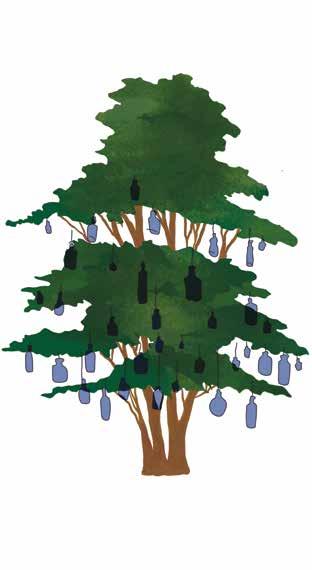
wood
In this suit we draw from Eastern traditions to incorporate the elemental energy of wood as a manifestation of the spirit of the natural world. The Taoist philosophy of the five elements expresses the dynamic balance of the universe through the interactions of earth, metal, fire, water, and wood. Fire can destroy wood, yet wood can feed fire; wood can break earth, yet earth can bury wood. The attributes of each element derive not only from its physical characteristics but also its metaphysical properties; achieving harmony through consciousness is the goal. Wood is associated with the capacity for creative growth and emergence, as represented by the spring season.
We interpret wood broadly as representative of the entire plant kingdom and examine the symbolism of plants and their roles in various cultural practices that are based on an awareness of their ecological value. An ecosystem is a complex network reliant on keystone plant species. Without plants there would be no life on earth. Plants provide food, habitat, medicine, even the air we breathe. Less obvious are the functions that plants perform in controlling erosion, preventing floods and landslides, pollinating crops, and storing carbon.
ORO Editions
Kokopelli is commonly recognized as the Hopi curved-back fluteplayer whose image first appeared on petroglyphs and Hohokam pottery over a thousand years ago. To many Indigenous groups in the American Southwest his spirit is associated with fertility of the land and the people. He is the harbinger of spring, a conveyor of resources, and transmitter of knowledge. There are many different interpretations of Kokopelli’s likeness and significance; he has been portrayed as a wandering storyteller, trickster, rainmaker, musician, seducer, and buffoon, whose flute playing spreads magic and mayhem as well as abundance and favorable auspices across the land.
To Puebloan peoples, Kokopelli is the ancestral spirit of the contemporaneous Flute Player Clan. His image incised on rocks and stones is believed to mark the historical migration patterns of their kin. Kokopelli is also the Hopi term given to a pair of male and female kachinas (or divine spirit beings) whose embodiment through dance and figurative art is used to communicate traditional social values.
Kokopelli is often described as “hump-backed,” an imperfect form, or a figure weighted down by the burden he carries. His image may have been inspired by the shape of an insect, such as an ant. In some versions of his story the sack he carries may be filled with seeds, a metaphor for the cultivation of wisdom and growth.

ORO Editions
ORO Editions
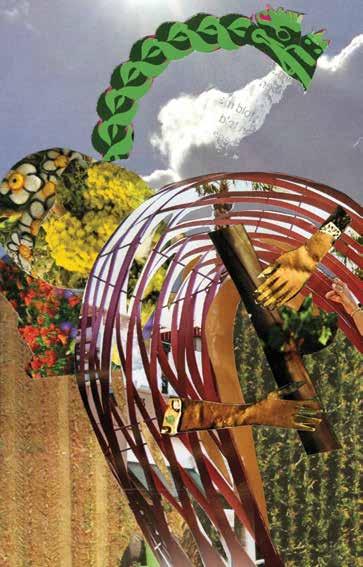
echoes

Have you ever spoken to the mountains, and received an answer in return? In Greek mythology, Echo is the name of an Oread, or mountain nymph, who was cursed by the goddess Hera to only repeat the words of others. An echo is a phenomenon of sound reflecting off a distant surface. The farther away the object, the more time it takes for the sound to return.
Many nocturnal and marine animals are sensitive to sound, and navigate, hunt, and forage by echolocation. Bats, dolphins, and whales emit sounds in a variety of ways and use echoes to identify the shape and location of different elements and creatures in the darkness of night and depths of the oceans. Sound travels faster through water than air, which makes “biological” sonar an efficient process.
Sonar, radar, and lidar are all contemporary technologies that use echoes to map things on earth that we can’t see, in essence giving a voice to the landscape. Sonar (Sound Navigation and Ranging) measures echoes from sound waves and is used to map the ocean floor. “Active” sonar has been known to cause acoustic trauma to whales, prompting legislation to curtail its use in certain regions. Radar uses radio waves to measure the size, quantity, speed, and direction of moving objects. Meteorologists predict weather patterns based on radar data from the interior of clouds. Lidar measures light reflected from laser pulses to accurately map the three-dimensional structure of the earth’s surface. Lidar can sense topographic features below a forest canopy and is an effective tool for environmental planning and landscape management.
Since time immemorial we call out to the land and listen for its wise response.
ORO Editions
ORO Editions
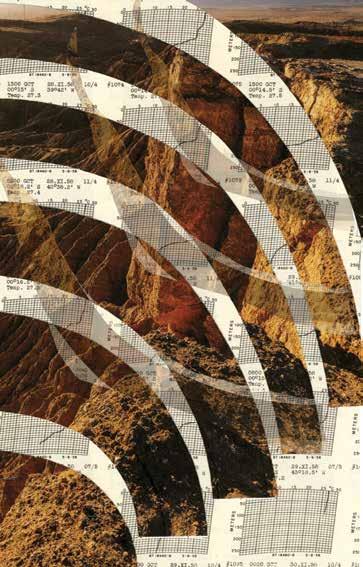
the primrose path
There is hardly a culture in the world that does not have some form of traditional belief in little people. They may take different forms or have different names, but all appear to have similar traits. Nowhere is the Faerie Faith more prevalent than in the Celtic countries of Ireland, Scotland, Wales, England, and Brittany, and with it is a specific relationship of the faerie folk to flowers. For instance, Blue Bells are especially revered by faeries, but they are also very dangerous to humans. If you wander into a ring of Bluebells, you might fall under the spell of a faerie enchantment. Also, you must be wary of ever disturbing the Bluebells, for if perchance you brush one of its flowers it can disrupt the spells which faeries place on the petals.
The Primrose Path has its origins in Celtic faerie mythology, and the flower has many legends associated with it. It boasts the unique power of making the invisible visible—eating primroses would allow you to see the faerie folk! On May Day, bouquets of primroses are hung over doors and windows to repel black magic and misfortune, only allowing white magic to enter. Being led down the Primrose Path means that one has been diverted from the straight and narrow pathway of purpose and taken an unexpected detour. Traveling down the Primrose Path means we are now open to enchantment, enlightenment, and magic. The direct route is what is expected but is not always the most rewarding.
Follow the trail of these lovely flowers and you will be rewarded with the unexpected. This is the path of life changing and mind-altering revelation.
ORO Editions

the primrose path
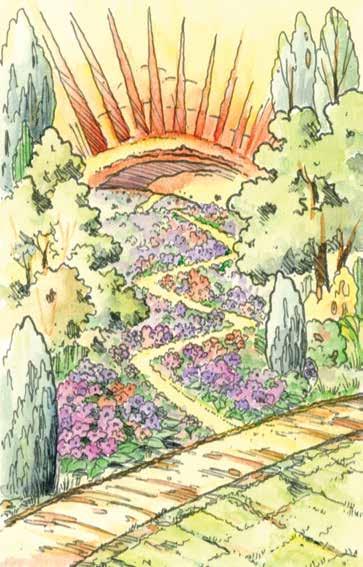
ORO Editions
hedge witches

Historically a hedge witch was a witch who was not a member of a coven and lived at the edge of the known world and the wilderness, beyond the hedge on the outskirts of town. As an inhabitant of the outskirts, the hedge witch was an intermediary between civilization and the natural world. More often women than men, hedge witches were healers, shamans, and keepers of extensive botanical knowledge of herbs and medicines. Much of their time was spent collecting plants and herbs and then using their home as a lab to analyze, study, and classify the effects of plants. The home was a workplace for study and a center for magical activity. Bookshelves were full of ancient magical texts, amulets, curative potions, and spells. Everywhere you looked plants accumulated in various stages of preparation for curatives. Detailed journals held records of the processes, recipes, and discoveries. The practice of the hedge witch was deeply personal and held a sincere reverence for nature; it was a journey grounded in the communion of the spirits of place.
The popularity of the Harry Potter films might foretell the dawn of a new age—an invitation to positive associations with the magical arts. There is a resurgence in the community of hedge witches in contemporary paganism. Today’s hedge witch is usually self-taught and self-motivated and not part of a broader ideology or dogma. To become a hedge witch you must first learn the medicinal and spiritual properties of everything that grows. A wise hedge witch enlists nature; we would do well to follow that advice.
ORO Editions
hedge witches
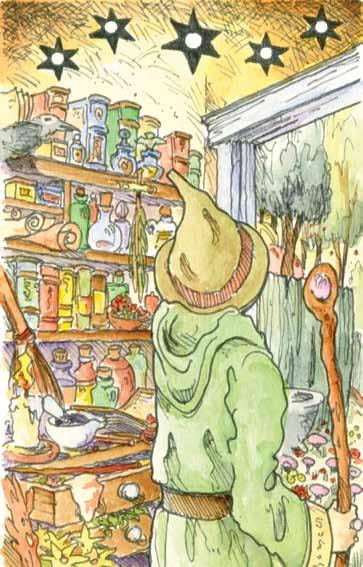
ORO Editions
asase yaa

Asase Yaa is the female spirit of the earth and the goddess of agriculture and fertility to the Indigenous Akan and Ashanti people of West Africa. Her name combines the words for Earth (asase) and Thursday (yaa) the day the earth was believed to be created, and hence the day that the earth must remain undisturbed and allowed to rest. There are no burials on Thursdays. Asase Yaa is venerated in tilled soil and plowed fields. Working a field is a sacred act. Prior to any excavation or agitation of the earth, a libation must be poured to seek permission to perform the work.
The Ashanti people of Ghana represent a matrilineal society. Asantehemaa is the title given to Queen Mothers, women elders who offer their counsel and wisdom to the community’s leaders. The concepts of stewardship and motherhood extend to attitudes and values toward the land. At death, Asase Yaa reclaims her children and, in asking her to accept the return of her people, a libation is offered. Similarly, at birth, when a child is placed on a mat on the ground as part of a naming ceremony called an “outdooring,” offerings of gratitude along with prayers for protection from the ancestral guardians are made to Asase Yaa.
Asase Yaa is also associated with truth and virtue. Her people are custodians of the land; land is not a commodity to be bought or sold, and people have a responsibility to keep the earth clean.
ORO Editions
ORO Editions
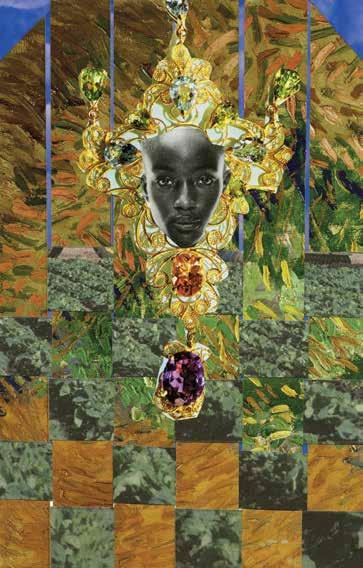
ORO Editions
